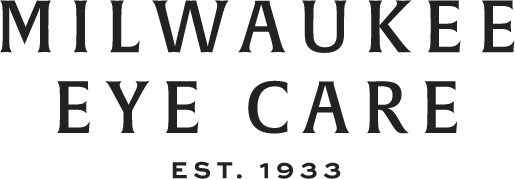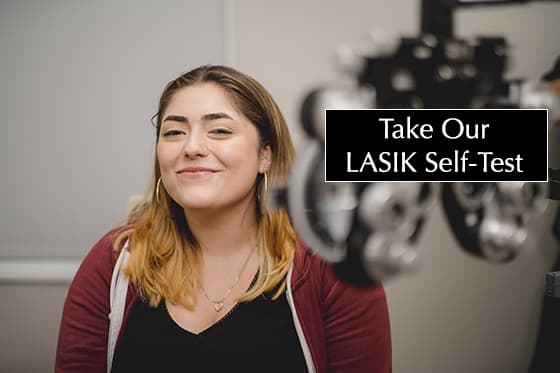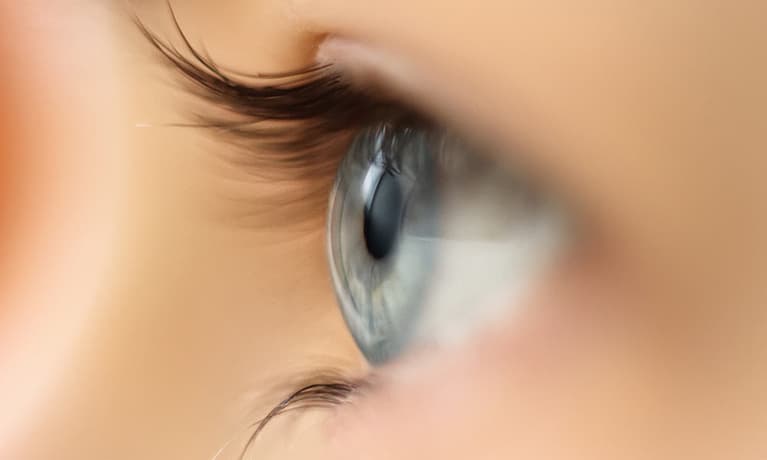LASIK in Milwaukee
Are you ready to free yourself from the restrictions of glasses and contact lenses? With LASIK at Milwaukee Eye Care, you can finally achieve the clear vision you’ve always dreamed of. Our leading technology and experienced LASIK surgeon can help you restore your vision in just minutes. With laser vision correction, you can finally enjoy activities like swimming, golfing, and skiing without the hassle of corrective lenses. Start your journey to better vision today – explore our refractive surgery options and find out how you can get the clear eyesight you deserve!
Milwaukee Eye Care is dedicated to providing exceptional LASIK, PRK, and laser vision correction services. Our specialty-trained LASIK surgeon, Dr. Jason Edmonds, is consistently recognized as Milwaukee’s Best LASIK Surgeon by The Shepherd Express, demonstrating his commitment to delivering excellent vision correction outcomes.
Using advanced technology supported by a team of experienced professionals, we offer thorough evaluations to personalize your vision correction journey. At Milwaukee Eye Care, our primary goal is to enhance your vision and elevate your quality of life.
Take the first step towards a clearer future. Schedule your consultation today to discover if LASIK is the right choice for you!















Transform Your Vision With LASIK at Milwaukee Eye Care
Since the 1970s, refractive surgery has been transforming lives, providing lasting solutions for nearsightedness, farsightedness, and astigmatism. The emergence of laser technology, beginning with photorefractive keratectomy (PRK), propelled eye care into a new era. This advancement allowed the development of precise methods such as LASIK, which combines the use of an excimer laser with the creation of a corneal flap, effectively reshaping the cornea to enhance visual accuracy.
If you are considering a reliable and efficient method to improve your vision, LASIK or PRK at Milwaukee Eye Care might be the perfect option for you. LASIK offers the dual benefits of laser precision and a quick recovery period, letting you enjoy the newfound clarity in no time. Alternatively, PRK provides an excellent option for those who prefer or require a no-flap procedure, with results that are equally impressive.
LASIK surgeon, Dr. Jason Edmonds, is here to assist you in determining the most suitable procedure based on your unique vision needs and health profile
LASIK Review for Dr. Jason Edmonds
LASIK Review for Dr. Jason Edmonds
Step-by-Step LASIK Experience
LASIK is a quick, comfortable procedure that can improve your vision in less than 30 minutes!
1. Preparation
As you settle in for the procedure, you’ll be given numbing drops to keep you comfortable. Your surgeon will also use a specialized instrument to gently hold your eyes open.
2. Creating the Flap & Reshaping Your Cornea
First, a femtosecond laser is used to create a thin flap of corneal tissue. With the flap temporarily lifted, a second laser reshapes your cornea, effectively changing your prescription. The flap is then gently placed back into position, allowing your eye to naturally heal.
3. Immediate Post-Procedure Check
Following the surgery, your ability to see will be immediately tested. You might be amazed as you read the time on a wall clock across the room, experiencing improvements in your vision.
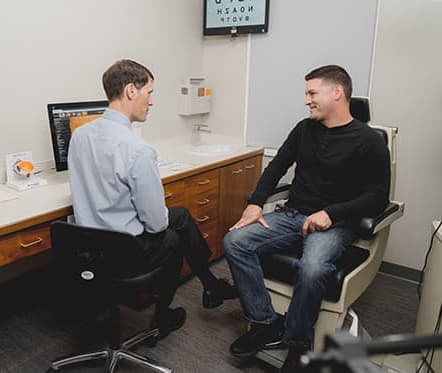
4. Post-Procedure Care
In the hours that follow the LASIK procedure, you may experience blurry vision, watery, dry, or itchy eyes. These symptoms are normal and improve greatly within 24 hours.
5. Follow-up Visit
You’ll have a follow-up appointment with your eye doctor the next day, where they will check how your corneas are healing and measure your vision. While it can take a few months for your eyes to completely heal and your vision to stabilize, most people can see comfortably enough to drive within a couple of days.
LASIK Frequently Asked Questions
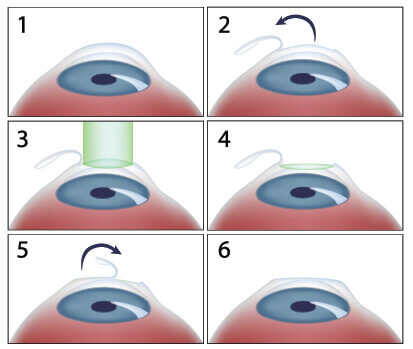
Wavelight® and Contoura® Vision LASIK
Wavelight LASIK is an advanced laser eye surgery technology that utilizes a detailed 3D map of your individual eye to customize the treatment, allowing for unparalleled precision and accuracy. The laser reshapes your cornea in a unique pattern that corrects your specific vision condition, reducing reliance on eyeglasses or contact lenses.
Contoura® LASIK differs by integrating advanced technology that allows even greater precision in reshaping the cornea. With this technique, Dr. Edmonds takes multiple eye measurements to consider cornea curvature variations. Contoura LASIK also provides customized adjustments based on individual vision needs.
Learn More About Advanced LASIK Treatments
What is a Refractive Error?
In normal vision, light enters the eye through the cornea and is focused at a single point on the retina at the back of the eye. With a refractive error, there is a defect in the way light passes through the eye. Light rays do not bend properly to achieve a single focus point. Instead, light rays focus in front of the retina (nearsighted), behind the retina (farsighted), or at two different points (astigmatism). Refractive errors usually result from a defect in the length of the eye or shape of the cornea.
Myopia (Nearsightedness)
Individuals with myopia or nearsightedness see close objects clearly but distant objects appear blurred.
Myopia is caused by a steeply curved cornea or elongated eye.
Hyperopia (Farsightedness)
Individuals with hyperopia or farsightedness see distant objects clearly but close objects are blurred.
Hyperopia is caused by a short eye.
Astigmatism
Astigmatism is caused by an unevenly curved or warped cornea.
Objects at all distances appear indistinct and distorted.
Reshaping Vision with LASIK
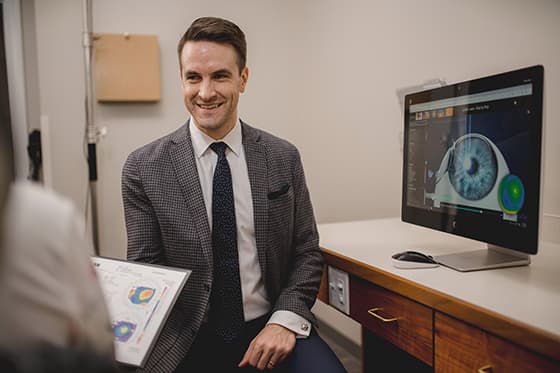
Instead of using heat to alter tissues like other lasers, an excimer laser beam breaks the bonds that link tissues together with only minimal effect on surrounding tissue. These unique properties allow the excimer laser to be used in the LASIK procedure to reshape tissue immediately beneath the surface of the corneal flap. After LASIK, light rays focus more precisely on the retina. A computer, programmed by the specialty-trained LASIK surgeons controls the laser and the reshaping of the cornea.
The procedure is performed while the patient lies on her/his back. As the laser beam expands or moves, a tiny lens-shaped disc is created. The focal point of the beam only penetrates the cornea about two-thousandths of an inch (about half the thickness of a human hair). Only a small area in the center of the cornea is treated. Finally, the corneal flap is replaced (without stitches) and the LASIK procedure is complete.
Is Monovision right for me?
As part of the natural aging process, our eyes gradually lose the ability to focus on near objects. Reading small print or reading in dim light becomes increasingly difficult. This natural loss of reading vision usually begins around the age of forty and progresses into our sixties. This natural, normal aging process of the eye is known as presbyopia. Presbyopia may be dealt with in a number of different ways. Reading glasses or bifocals accommodate this loss of reading vision. Another method of correction, which works well for many individuals, is known as monovision. Most people use contact lenses to achieve monovision; however, monovision is also possible with the LASIK procedure.
With a monovision correction, one eye is corrected for distance vision and the other eye is left slightly under-corrected for reading vision. Since it is your brain rather than your eyes that interprets what you see, your brain is able to selectively focus on the clear image while the blurry image is suppressed. Because both eyes are in constant use, monovision will not cause any harm to your eyes. Your specific visual needs are important to us. Your eye surgeon will discuss the correction options available to you at your pre-operative evaluation. If you are interested in monovision, you may be fitted with monovision contact lenses prior to your surgery to help you and the doctor decide if monovision is right for you. In a small percentage of people, a monovision correction may not be accepted. If this is the case, the eye which was left slightly under-corrected for reading vision may be enhanced to full distance correction. To learn more about options for correction of presbyopia click here.
